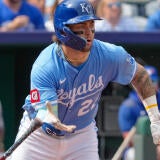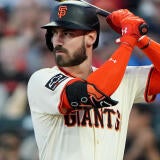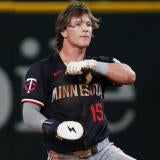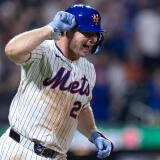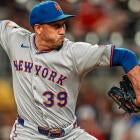Fantasy baseball waiver wire: Chase Burns returns but his Fantasy impact may be delayed until 2026
Plus, if you're looking for upside, Otto Kemp could be the solution
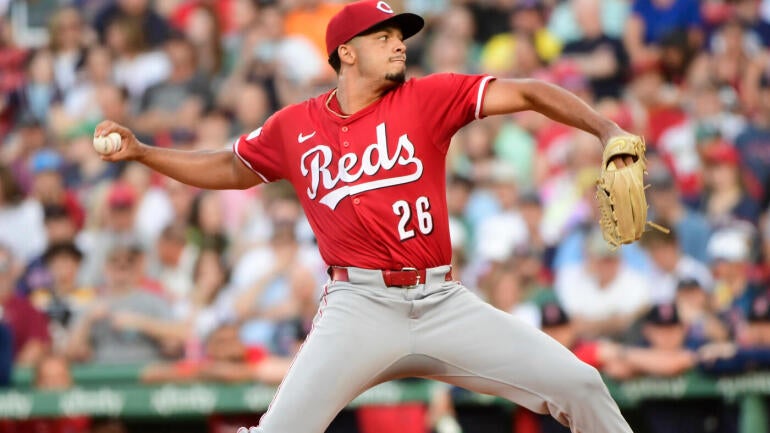
Chase Burns is back, and in theory, that's exciting news. It certainly is for the Reds, who get one of the most exciting young pitchers in the game back in for the stretch run. With the Reds sitting just 1.5 games back of the Mets (and owning the tiebreaker), that could be a huge deal for them.
But it probably doesn't matter much for Fantasy. And that's kind of a bummer.
Burns will be activated from the IL after missing the past few weeks with an elbow injury, but the plan right now is for Burns to return for the final two or so weeks of the season while pitching out of the bullpen. Whether that's as a multi-inning reliever or potentially a high-leverage weapon, he could make an impact for the Reds in some key spots. But that's not likely to matter much for Fantasy if he's limited to pitching every three or four days and not likely to factor into many decisions.
Which forces us to turn our focus (as we've been doing lately here at Fantasy Baseball Today HQ) to 2026. Burns made eight starts before his injury, and if you go by the 5.24 ERA, there wasn't much to get excited about. But if you take away just one start against the Red Sox back in June, that ERA drops to 3.97. That's not an ace-level result, but the underlying numbers sure back that up, at least, whether you're looking at the 3.17 xERA or the 2.47 FIP he put up.
Or you can just ignore the overall numbers and just look at start-by-start results, and they'll paint a similar picture. Burns struck out at least 10 batters in four of his starts, which ties him for the sixth-most 10-K outings in the majors. Tarik Skubal, naturally, leads the majors in these outings with 10, which represents around 36% of his starts; Burns did it in half of his.
It's just an eight-start sample size so far, of course, but it's not like Burns' career started with those eight games. He was one of the most dominant pitchers in the country as a junior at Wake Forest, posting a 2.70 ERA and striking out 48.9% of opposing hitters – Paul Skenes struck out 45% of hitters in his final season in college – and kept right on dominating professional hitters after the Reds made him the No. 2 pick in last summer's draft. In 13 starts in the minors, Burns had a 36.8% strikeout rate and 1.77 ERA.
Which is to say, all Burns has done against high-level competition is dominate. He wasn't quite dominant in his time as a starter for the Reds, but he certainly showed that kind of upside. It's a small sample size, but it's also backed up by the sheer quality of the stuff on display – among starters who threw even 30 innings this season, Burns' Stuff+ store of 113 rated out as the 10th-best mark, just behind Cristopher Sanchez. Add in the Location+ component to account for his overall quality, and Burns jumps to fourth, behind only Tarik Skubal, Hunter Greene, and fellow rookie Jacob Misiorowski. Or you can ignore the fancy, newfangled, model-based metrics and just look at the pitches themselves – a four-seamer that sits at 98.4 mph and a wicked slider at 90.5, plus the occasional curveball and changeup, just in case the first two weren't tough enough to account for.
You add it all up, and Burns has comparable upside to teammate Hunter Greene, who I made the case for as a top-12 SP for 2026 earlier this week. Burns is less proven than Greene, who has pitched at that level for two seasons against major-league competition, so he doesn't need to be ranked that high for 2026. But if the upside is there and he's guaranteed a rotation spot with the runway to throw 150-plus innings, I do think we have to treat Burns as a significant difference maker for Fantasy.
Does that mean he's a top-24 SP in the rankings already? I'm not sure I'm ready for that, but I can't rule it out either. I feel comfortable placing him in the top-36, at least, and he might end up in the top 24 of the rankings by the time I put together my first draft in early October. It's just a bummer he likely won't matter much for Fantasy in September.
Here's what else you need to know from around the majors heading into the weekend.
For more Fantasy baseball insight, sign up for our newsletter and get the edge you need to win your league.
Friday's top waiver-wire targets
Otto Kemp, 3B, Phillies (3%) – Kemp put together some pretty exciting numbers in the minors, hitting .310/.417/.570 at Triple-A this season with 16 homers and 13 steals in 74 games. He hasn't been nearly that productive in the majors, but he's starting to flash the upside, homering Thursday and putting together five hits and a couple of homers in his past three games. He's playing pretty much every day with Alec Bohm on the IL, and if you need some upside at 1B, 3B, or OF, he's worth a look.
Connelly Early, SP, Red Sox (24%) – Early looked like a star in his debut earlier this week, becoming just the 17th major-league pitcher to strike out at least 11 in his debut. The Red Sox haven't confirmed what their plans for the young lefty's follow-up will be, but with Payton Tolle struggling in his last two starts, I'd bet on Early hanging around, and the schedule is looking extremely favorable for next week – it's looking like he'll get two starts, one against the Athletics lineup he just dominated and then another against a Rays lineup that rarely rises above "fine." Early looked so good in his debut – after a breakout season in the minors – that even in a key Fantasy matchup, I think he looks worth trusting this week.
Ryan Weathers, SP, Marlins (26%) – I wish I could suggest Weathers as a waiver-wire add with my whole chest, but he probably isn't worth all that. With just two or three starts left, the next matchup really matters, and unfortunately, Weathers looks like he's going to be pitching in Coors Field next week. He looks good in his return from a flexor muscle strain Thursday against the Nationals, striking out four over five shutout innings, and his stuff mostly looked to be where it needed to be despite the injury. But you probably don't want to trust Weathers against the Rockies in Colorado, and then he'll finish the season against the Phillies and possibly the Mets in the final week, neither of which is an ideal situation. Weathers is a good pitcher - 3.40 ERA over the past two seasons – but he's just a fringe option for the final few weeks, given the matchups.
Wednesday's standouts
Kevin Gausman, Blue Jays vs. HOU: 9 IP, 2 H, 0 ER, 1 BB, 9 K
My skepticism of Gausman has been noted many times in this newsletter, but he deserves a lot of credit for the way he's turned his season around, putting together a 2.25 ERA and 0.74 WHIP in the second half of the season. His strikeout rate isn't quite where it was at his best, but a 25% rate will play, especially with his command playing much better lately. Splitter-dependent pitchers carry an inherent risk with them, and Gausman will be 35 on Opening Day in 2026, so I don't want to get too excited about him. But there was a point where I wasn't sure he was even a top-50 SP anymore, and now I'm thinking he might be a top-36 option for next season's drafts. That's a nice way to turn your season around.
Junior Caminero, 3B, Rays: 2 for 4, 1 HR, 2 RBI
I went deep on Caminero last week when he hit his 40th homer, and he really hasn't slowed down, as he hit his 42nd Thursday. I don't have a ton new to add – he's a phenomenal power hitter, but probably needs to tighten up his swing to add batting average upside to the homers – but I do want to address something Frank Stampfl brought up on Thursday's episode of Fantasy Baseball Today: The Rays' expected move back to Tropicana Field for 2026. The Rays have spent 2025 playing their home games at George M. Steinbrenner Field, an outdoor stadium in Tampa with the same hitter-friendly dimensions as Yankee Stadium.
Single-season park factors are prone to a lot of noise, but Steinbrenner Field has more or less played like we expected, with a solid (but not extreme) lean towards being hitter-friendly, with the fifth-highest HR park factor among all stadiums according to BaseballSavant.com's data. Tropicana Field, by comparison, was the third-toughest park for hitters in the three years prior to 2025, with a slight depressing effect on homers and a significant inflationary effect on strikeouts. The latter is the biggest way Tropicana stood out in years past, and it represents an unknown factor for analyzing a player like Caminero, who has middling swing decisions but manages to strike out at a roughly league-average rate thanks to strong contact skills. Some players struggle to see the ball well at Tropicana – Willy Adames being a notable example – and that could impact Caminero more than expected. Or it could be just a minor downgrade. I'm not really factoring the park change into my 2026 ranking for Caminero, but I think it's a reasonable tiebreaker if you want to take someone like Nick Kurtz ahead of him. Either way, Caminero looks like one of the premier power bats for the next decade or so, and if he manages to take a step forward as a source of batting average, he could very well mash his way into first-round consideration.
Mackenzie Gore, Nationals @MIA: 5 IP, 4 H, 2 ER, 2 BB, 4 K
Anytime a pitcher is coming back from an injury, the primary thing I want to see in their first start back is no lingering physical limitations, and I didn't really see any red flags in Gore's return from a shoulder injury Thursday. His velocity was down about 0.5 mph on his four-seamer, which isn't nothing, but is well within the normal range you'd expect to see from a pitcher in any given start. And it didn't really impact his production against the Marlins, either. Gore will get the Braves next week, and while that isn't a slam-dunk matchup, the Braves have been hit-or-miss enough this season that I'm probably just throwing Gore back in my lineup for the stretch run.
Bryce Miller, Mariners vs. LAA: 5.2 IP, 6 H, 4 ER, 0 BB, 11 K
Miller is perplexing. He's been pitching through bone spurs in his elbow for much of the season, but has been throwing harder since coming back from the injury than he was before. The problem is, he just hasn't been all that effective in spite of that – the 11 strikeouts (a career-high!) here were nice to see, but he once again struggled to keep runs off the board. He has a 5.33 ERA since returning from the IL with nine homers in five starts, and while I think he's a viable streamer for next week against the Royals, he's certainly not a must-start option. As for 2026? I suspect Miller will have surgery to clean up his elbow in the offseason, and my view on him will likely depend on what we see in Spring Training. But right now, I'm inclined to leave him outside of my top-50 starters for next season.
Cristian Javier, Astros @TOR: 6 IP, 6 H, 4 ER, 1 BB, 6 K
Javier has certainly flashed upside since coming back from elbow surgery, and the strikeout-to-walk ratio in this one was especially nice to see. The ERA is inflated, but there aren't exactly a ton of warning signs – he has been limiting hard contact well so far, including with an 88.9 mph average exit velocity against Thursday. Is that enough to make Javier a must-start pitcher down the stretch? Probably not, though I think he's a viable streamer for next week against the Rangers, and could be even more than that for the final week of the season, with what could be a two-start slate against the Athletics and Angels. There's a lot of swing-and-miss in those two lineups, and Javier could close the season out strong as a result.
Chandler Simpson, OF, Rays: 4 for 4, 1 R, 1 SB
We don't typically care much about defense for Fantasy, but it obviously matters in helping keep players on the field. And even more than the low-OBP and nonexistent power, it's Chandler's mediocre defense that threatens to cost him playing time in the long run for the Rays. That hasn't been much of an issue since his return from Triple-A, though, and his athleticism makes him a decent bet to figure that out in the long run. And Simpson is already a standout in at least two categories, with his batting average up to .290 and his 40 steals coming in just 96 games. He could legitimately lead the league in steals in 2026 by a wide margin while hitting .300 or better, and if there's any growth in his on-base skills, he could even be a standout in runs. It's a fringe-y profile in an era where steals are more plentiful than ever – is there that much of a difference between Simpson and Victor Scott if his batting average slips? – but it's the kind that could make it so you really don't have to even think about steals. That's probably enough to make him a top-150 pick for 2026, and that might be underselling Simpson's outlier speed.
Cameron Schlittler, Yankees vs. DET: 6 IP, 5 H, 1 ER, 2 BB, 7 K
It was nice to see Schlittler bounce back from a really terrible start the last time out with another solid start in a rookie season that has mostly been solid. He comes at hitters with what has become a pretty dominant fastball, and it generated nine whiffs Thursday. It's the rest of the arsenal that hasn't quite caught up yet, and I would guess Schlittler will spend the offseason working on his secondaries to identify one more go-to putaway pitch. He's more than held his own as is, with a 3.05 ERA (albeit with a more unseemly 1.32 WHIP) as a rookie. Schlittler's fastball gives him a large margin for error, and there's plenty of room for growth from where he's at. He's probably pitching his way into a top-50 SP ranking for 2026.
Cade Povich, Orioles vs. PIT: 5.2 IP, 5 H, 2 ER, 2 BB, 6 K
I remain pretty intrigued by Povich and these (occasional) flashes we're seeing from him. I'm just not sure what he needs to do to go from "intriguing" to "actually useful." His changeup is a legitimately solid swing-and-miss pitch, while his curveball has flashed at times, and he combined for 12 swings and misses Thursday. The problem here, really, is that Povich just doesn't generate many chases, as hitters swing at pitches out of the strike zone just 25.2% of the time this season (league average is 28.4%). You can survive without generating a lot of chases if you miss bats in the zone, but Povich doesn't do that, with an above-average 83.1% in-zone contact rate. His fastballs actually aren't bad swing-and-miss pitches (19.7% with his four-seamer and 20.8% with the sinker), but the four-seamer especially gets hit really hard when hitters do make contact, and his command isn't precise enough to find the edges of the zones consistently enough to limit that damage. There are some pieces here, but Povich needs to show us a lot more in his final couple of starts to have any appeal for Fantasy in 2026.


